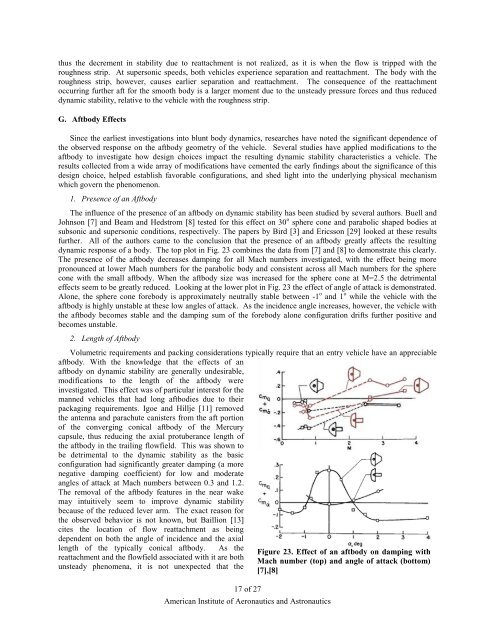Survey of Blunt Body Dynamic Stability in Supersonic Flow
Survey of Blunt Body Dynamic Stability in Supersonic Flow
Survey of Blunt Body Dynamic Stability in Supersonic Flow
Create successful ePaper yourself
Turn your PDF publications into a flip-book with our unique Google optimized e-Paper software.
thus the decrement <strong>in</strong> stability due to reattachment is not realized, as it is when the flow is tripped with the<br />
roughness strip. At supersonic speeds, both vehicles experience separation and reattachment. The body with the<br />
roughness strip, however, causes earlier separation and reattachment. The consequence <strong>of</strong> the reattachment<br />
occurr<strong>in</strong>g further aft for the smooth body is a larger moment due to the unsteady pressure forces and thus reduced<br />
dynamic stability, relative to the vehicle with the roughness strip.<br />
G. Aftbody Effects<br />
S<strong>in</strong>ce the earliest <strong>in</strong>vestigations <strong>in</strong>to blunt body dynamics, researches have noted the significant dependence <strong>of</strong><br />
the observed response on the aftbody geometry <strong>of</strong> the vehicle. Several studies have applied modifications to the<br />
aftbody to <strong>in</strong>vestigate how design choices impact the result<strong>in</strong>g dynamic stability characteristics a vehicle. The<br />
results collected from a wide array <strong>of</strong> modifications have cemented the early f<strong>in</strong>d<strong>in</strong>gs about the significance <strong>of</strong> this<br />
design choice, helped establish favorable configurations, and shed light <strong>in</strong>to the underly<strong>in</strong>g physical mechanism<br />
which govern the phenomenon.<br />
1. Presence <strong>of</strong> an Aftbody<br />
The <strong>in</strong>fluence <strong>of</strong> the presence <strong>of</strong> an aftbody on dynamic stability has been studied by several authors. Buell and<br />
Johnson [7] and Beam and Hedstrom [8] tested for this effect on 30 o sphere cone and parabolic shaped bodies at<br />
subsonic and supersonic conditions, respectively. The papers by Bird [3] and Ericsson [29] looked at these results<br />
further. All <strong>of</strong> the authors came to the conclusion that the presence <strong>of</strong> an aftbody greatly affects the result<strong>in</strong>g<br />
dynamic response <strong>of</strong> a body. The top plot <strong>in</strong> Fig. 23 comb<strong>in</strong>es the data from [7] and [8] to demonstrate this clearly.<br />
The presence <strong>of</strong> the aftbody decreases damp<strong>in</strong>g for all Mach numbers <strong>in</strong>vestigated, with the effect be<strong>in</strong>g more<br />
pronounced at lower Mach numbers for the parabolic body and consistent across all Mach numbers for the sphere<br />
cone with the small aftbody. When the aftbody size was <strong>in</strong>creased for the sphere cone at M=2.5 the detrimental<br />
effects seem to be greatly reduced. Look<strong>in</strong>g at the lower plot <strong>in</strong> Fig. 23 the effect <strong>of</strong> angle <strong>of</strong> attack is demonstrated.<br />
Alone, the sphere cone forebody is approximately neutrally stable between -1 o and 1 o while the vehicle with the<br />
aftbody is highly unstable at these low angles <strong>of</strong> attack. As the <strong>in</strong>cidence angle <strong>in</strong>creases, however, the vehicle with<br />
the aftbody becomes stable and the damp<strong>in</strong>g sum <strong>of</strong> the forebody alone configuration drifts further positive and<br />
becomes unstable.<br />
2. Length <strong>of</strong> Aftbody<br />
Volumetric requirements and pack<strong>in</strong>g considerations typically require that an entry vehicle have an appreciable<br />
aftbody. With the knowledge that the effects <strong>of</strong> an<br />
aftbody on dynamic stability are generally undesirable,<br />
modifications to the length <strong>of</strong> the aftbody were<br />
<strong>in</strong>vestigated. This effect was <strong>of</strong> particular <strong>in</strong>terest for the<br />
manned vehicles that had long aftbodies due to their<br />
packag<strong>in</strong>g requirements. Igoe and Hillje [11] removed<br />
the antenna and parachute canisters from the aft portion<br />
<strong>of</strong> the converg<strong>in</strong>g conical aftbody <strong>of</strong> the Mercury<br />
capsule, thus reduc<strong>in</strong>g the axial protuberance length <strong>of</strong><br />
the aftbody <strong>in</strong> the trail<strong>in</strong>g flowfield. This was shown to<br />
be detrimental to the dynamic stability as the basic<br />
configuration had significantly greater damp<strong>in</strong>g (a more<br />
negative damp<strong>in</strong>g coefficient) for low and moderate<br />
angles <strong>of</strong> attack at Mach numbers between 0.3 and 1.2.<br />
The removal <strong>of</strong> the aftbody features <strong>in</strong> the near wake<br />
may <strong>in</strong>tuitively seem to improve dynamic stability<br />
because <strong>of</strong> the reduced lever arm. The exact reason for<br />
the observed behavior is not known, but Baillion [13]<br />
cites the location <strong>of</strong> flow reattachment as be<strong>in</strong>g<br />
dependent on both the angle <strong>of</strong> <strong>in</strong>cidence and the axial<br />
length <strong>of</strong> the typically conical aftbody. As the<br />
reattachment and the flowfield associated with it are both<br />
unsteady phenomena, it is not unexpected that the<br />
17 <strong>of</strong> 27<br />
American Institute <strong>of</strong> Aeronautics and Astronautics<br />
Figure 23. Effect <strong>of</strong> an aftbody on damp<strong>in</strong>g with<br />
Mach number (top) and angle <strong>of</strong> attack (bottom)<br />
[7],[8]
















